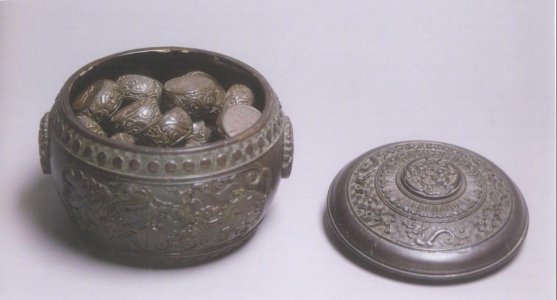Old Xiangqi pieces
According to Xiangqi historian Peter Banaschak, the oldest known unearthed sets are the following:
-
a complete set with 32 pieces found in 1984 near Anxi (Anyi) in Jiangxi province. Copper. 2 sides, red and black. The discs had characters on one side and pictures on the other. The two Ministers of each side were differentiated through two slightly different characters. Dated to the era Chongning (1102-1106).
-
another complete copper set, same period, in Kaifeng. Inscribed with Chinese characters on one side, and bore pictures on the other side. The ministers were not differentiated.
-
another complete copper set (32 pieces) excavated from a hoard dating to about 1102-1110 in Zhangming zhzn, Jiangyou City, Sichuan. They have a script on one side and an image fitting the name on the other side.2 Jiang (seated General), 4 Shi (Guards with a sword), 4 Xiang (Majestic Elephant), 4 Ju (Charriot pulled by an horse), 4 Ma (War Horse), 4 Pao (Catapult) and 10 Zu (Armored soldier). There is no color apparent to distinguish the sides.
-
a complete set of 32 ceramic round pieces, half white, half black, with incised characters for Jiang (General), Shi (Guards), Xiang (Minister or Elephant), Ju (Charriot), Ma (Horse), Pao (Catapult) and Zu (Soldier) filled with cinnabar. Dated to the Chongning era (1102-1106).
-
a bronze set found in Inner Mongolia in 1954. Inscribed on one side and engraved on the other side. Dated to about 1270.
-
two wooden sets of a total of 20 Xiangqi pieces found in 1974 in a wreck in the Quanzhou bay in Fujian province, dated to late Southern Song times (1127-1279) or early Yuan period (1279-1368).

Xiangqi set found
in archeological
excavation near
Beijing. Dated from North Song era, circa 1105. The
value of every piece is given by a drawing on the
upper face and an ideogram on the lower face. The
General is inside a tent, the Guards seems armored,
and Cannons are Catapults.
In the years 1973 to 1974 an excavation of a sea-going vessel was carried out in the Quanzhou bay in Fujian province. During this excavation 20 wooden Xiangqi pieces were found. They must have belonged to two sets, as one piece, a Horse, was marked through an engraved character that was filled up with red paint; the others were inscribed with red resp. black China ink. The ink-marked set had the differentiated Ministers as well. The wreck was dated to Southern Song times (1127-1279). It may be interesting to note that the simpler pieces were found near the crew quarters, so it may be acceptable to presume that Xiangqi began to gain popularity at about this time (though it is of course possible [maybe even probable] that it became more widespread earlier).
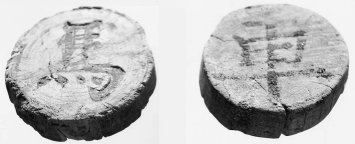
Wooden piece (Horse and
Chariot) found in a wreck in the Quanzhou bay
(Fujian), dated to Southern Song times (1127-1279)
(Courtesy of Thierry Depaulis)
INTRIGUING !
This object looks like a bronze coin; it has been found by Albert von Le Coq in Gaochang (=Chotscho) (see http://en.wikipedia.org/wiki/Gaochang) and reported in his account "Koeniglich Preussische Turfan-Expeditionen" published in 1913. (check for pages 217 & 218).
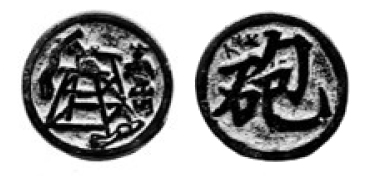
Gaochang is an ancient oasis of the Silk Road, 30km southeast of modern Turpan in Xinjiang, today in China. One side shows a catapult with a Chinese soldier; the second side wears the Chinese symbol "p´ao" which is the name of the piece in Xiangqi. Excavated from the rubble in front of the "library ", ruin K, Chotcho. This place was an active Buddhist place from 5 to 7th centuries, and it would be interesting to know if that piece comes from that remote era. However, the design of this piece looks very similar to Xiangqi pieces from the Song period.
Along with that piece a Persian-like Chariot was found. See it there. (Maybe more information can be found in Le Coq book available on line, but my German is too much limited. Any help will be appreciated).
TANGUT XIANGQI?
An ancient piece has been discovered in Wuwei, a city in the Gansu province (North West of China, at the eastern end of the Silk Road), bearing writing in Chinese in one side and in Tangut script in the other side. This copper piece has a diameter of 2.5 centimeters and the character "Shi" (a Counsellor in Xiangqi) cast on one side and Tangut word cast on the other side.
The extinct Tangut language was used under Western Xia Dynasty which ruled from 1038 up to 1227 in North-West China. This language disappeared after the fall of this bright kingdom, destructed by the Mongols.
This place demonstrates that Xiangqi was played by Tanguts. Andrew West has written an excellent article resuming all known facts about Tangut Chess. This precious document has been mirrored here for security.
CHESS CHARMS
Coins collectors know that several ancient Chinese coins are not monetary but are "Chess" pieces instead. Indeed, antique metal pieces made for Xiangqi play are often found. Coins collectors call them "charms". According to a web source, the National Museum of Chinese History in Beijing is known to have four complete sets of Northern Song (960 - 1127 AD) xiangqi pieces. The Shanxi Museum of History has one complete set of Northern Song pieces. There are no complete sets of these early Song Dynasty xiangqi pieces known to exist in private hands.
Zu:
Zu is black Soldier (Pawn) in Xiangqi. It seems to be the most common piece found in collections. Some coins bear the Zu sinogram on both side whereas others have a representation of a Soldier (with a kind of hallebard) on the reverside side.
|
|
|
|
|
|
|
Diameter 26.5 mm, weight 8g, www.zeno.ru |
|
|
|
|
|
Diameter is 29.5 mm, the thickness is 2.2 mm, and the weight is 10.2 grams. Private collection |
|
|
|
|
|
Unearthed in Primor'e, Russian Far East, www.zeno.ru |
|
|
|
|
|
This piece has a diameter of 22 mm, a thickness of 3 mm, and a weight of 9.8 grams. Private collection |
|
Bing:
Bing is red Soldier (Pawn) in Xiangqi. The same representation of a Soldier than for the Zu is found on the reverside side.
|
|
|
|
|
|
|
Southern Song. Diameter: 49mm, www.zeno.ru |
|
|
|
|
|
This piece was
reportedly found near the Sumatra River in
Indonesia and probably dates to 1750-1800. |
|
Jiang:
Jiang is the black General, the head of black army. This piece has the same sinogram on both sides.
|
|
|
|
Diameter 33 mm, weight 12.85g, www.zeno.ru |
|
Shi:
This Shi is the red Counsellor. The back side depicts the silhouette of a Guard, although it is difficult to see because of the erosion of the coin.
|
|
|
|
diameter of 26 mm, thickness of 2.2 mm, weight of 7.2 grams. Private collection |
|
Xiang:
This Xiang is the black Elephant. On these two pieces, both sides bear the same sinogram.
|
|
|
|
Unearthed at Selitrennoe site, Astrahan', Russia (the Golden Horde capital city Sarai), diameter of 26.5 mm, weight of 8.35 grams, www.zeno.ru |
|
|
|
|
|
diameter of 32.5 mm, thickness of 2.5 mm, weight of 11.9 grams.Private collection |
|
|
|
|
|
diameter of 25.5 mm, thickness of 1.5 mm, weight of 5.8 grams. Private collection |
|
This second Xiang is on the red army. The sinogram does not mean Elephant but Minister. Ankwardly, the reverse side shows ... an elephant!
|
|
|
Ma:
Ma is the Horse.
|
|
|
|
diameter of 24 mm, thickness of 2.2 mm, weight of 5.5 grams. Private collection |
|
|
|
|
|
diameter is 23.5 mm, thickness is 3 mm,weight of 9.1 grams. Private collection |
|
Ju:
Ju (or Che) is the Chariot. The first piece is from the red army as the sinogram uses two signs, the first one meaning "man" and being only used for the red set. When Ju is written with a single sign, it can not be asserted (without any trace of color) to which army it belongs. For all pieces, the reverse side show an image of a Chinese chariot. It can be noted that the last one is not the same than the first two ones.
|
|
|
|
|
|
|
|
|
|
diameter of 25 mm, thickness of 2.2 mm, weight of 6.4 grams. Private collection |
|
Pao:
Pao is the Cannon. It is written with a double sign sinogram. On the piece below, the first part of the sinogram is the sign for "stone" meaning that the piece is actually a Catapult. Generally, this is reserved for the black army, the red army having a real Canon which is written with the sign of "fire".
|
|
|
|
Song Dynasty. Diameter: 26mm?, www.zeno.ru |
|
Complete set:
A complete set of thirty-two bronze Xiangqi pieces found in Inner Mongolia (Northern Song period). The Generals are a little bit bigger than the other pieces. Both armies has the same design for the piece which is unusual nowadays.
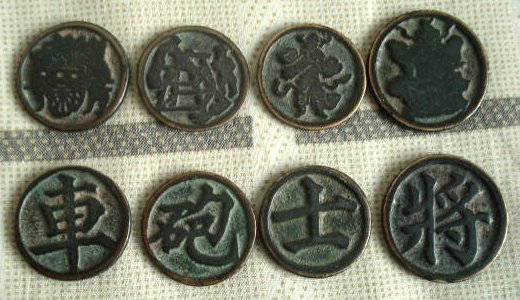
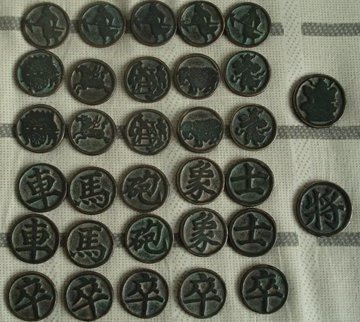
Source: 中国文物收藏交易网
The presentation of all these
Xiangqi copper or bronze "coins" demonstrate that they
were rather numerous. It is very surprising to note
that the cast images seem to always keep the same design
for a given piece. I don't know how this can be
explained. I was expecting much more variety, giving
the immensity of the Chinese lands and the span of years
(at least Norther and Southern Song dynasties, three
centuries from 960 to 1279). I'd be glad to receive
comments or complementary information on that
subject.
MORE OLD PIECES AND SETS, OTHER MATERIALS
Note: Most images here have been taken from a page in a Peter Sung's blog that I can not find again
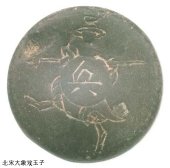
Bing: jade, Northern Song Dynasty (960-1127)
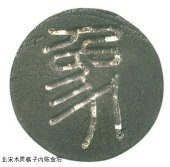
Xiang: wood, Northern Song Dynasty (960-1127)
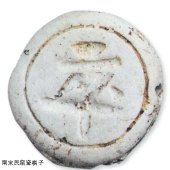
Zu: ceramic, Southern Song Dynasty (1127-1279)
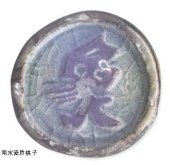
Xiang: ceramic, Southern Song Dynasty (1127-1279)
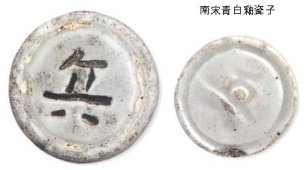
Bing: ceramic, Southern Song Dynasty (1127-1279)
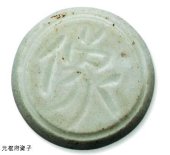
Xiang: ceramic, Yuan Dynasty (1271-1368).
Note the presence of the left part
of the sinogram which is used for the red army on
other pieces (Shi, Ma, Ju). The right part is the
sinogram of "elephant" which is a curiosity as the red
army usually has a "minister" instead of an "elephant"
as the Xiang.
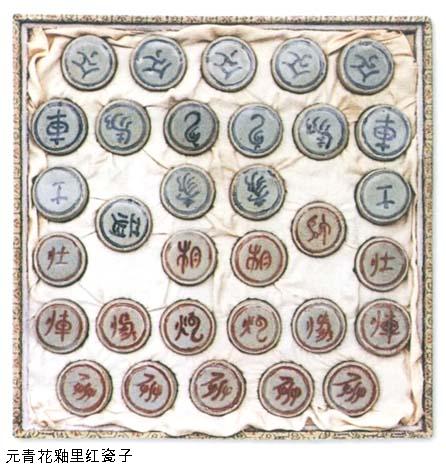
Ceramic set, Yuan Dynasty (1271-1368).
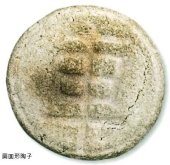
Ju: ceramic
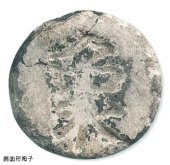
Xiang?: ceramic
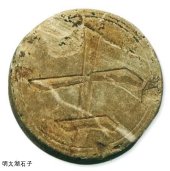
Shi: taihu stone, Ming Dynasty (1368 -1644)
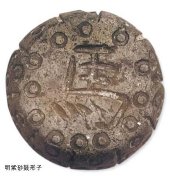
Ma: Ming Dynasty (1368 -1644)
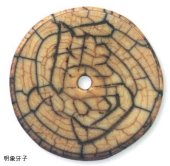
Ma: ivory, Ming Dynasty (1368 -1644)

Pao, Zu, Ma: Ming Dynasty (1368 -1644),Gold Wire Nanmu
wood
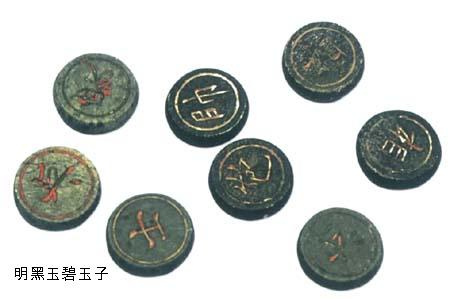
Ming Dynasty (1368 -1644), Black and green jade
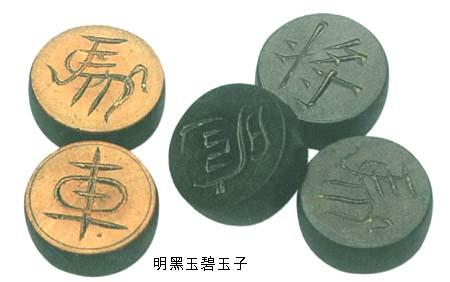
Ming Dynasty (1368 -1644), Black and green jade
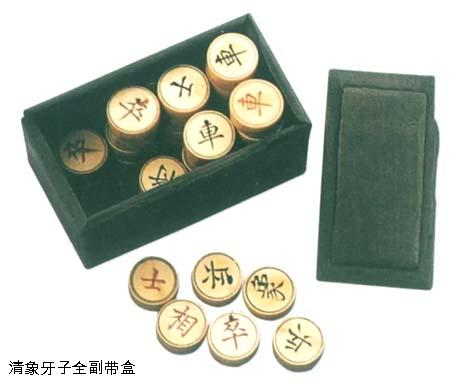
Full set of ivory with box: Qing Dynasty (1636-1912)





















































